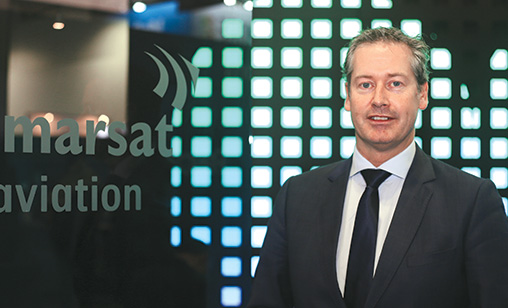Communications
The “connected aircraft” will transform airline operations
Equipment to track any aircraft flying anywhere across the globe is market ready, reports chief correspondent, Tom Ballantyne, as the International Civil Aviation Organisation moves closer to mandatory 15 minute monitoring of the journeys of every commercial airliner in the world.
September 1st 2018
The disappearance of Malaysia Airlines flight MH370 above the Indian Ocean on March 8, 2014 was a tragic wake-up call for the aviation industry, Inmarsat senior vice president, Strategy and Business Development, Frederik van Essen, told Orient Aviation during the recent International Air Transport Association’s 74th annual general meeting in Sydney. Read More »
As a result, the communications company, as well as its rivals, has developed fully digital systems that can constantly track all airplanes in flight across the globe. The technology meets the requirements of the International Civil Aviation Organization’s (ICAO) proposed Global Aeronautical Distress Safety System (GADSS).
 |
Inmarsat introduced its SwiftBroadband-Safety (SB-S) monitoring system to customers in April at the International Air Transport Association’s (IATA) Safety and Ops conference in Montreal.
“In addition to the current services it provides a secure internet link to the cockpit. Included in the service is free position tracking,” said van Essen. Among carriers operating the system, although it has not been mandated by ICAO, is China’s Shenzhen Airlines and Hawaiian Airlines.
The Civil Aviation Administration of China (CAAC) has ruled its airlines must contact ground operations every four minutes. “That is driving take-up from Chinese airlines,” said van Essen. “The Chinese market is a difficult market to operate in. There are a lot of special requirements.” After a 12-month trial, Qatar Airways inaugurated the Inmarsat system for tracking the Doha-headquartered airline’s flights worldwide.
Since the disappearance of MH370, ICAO has been working towards implementation of GADSS, which will require all aircraft to position report automatically at least every 15 minutes from November this year. By 2021, all airlines must have the capacity to report their aircraft every one minute if one of them is in distress.
The Inmarsat system can, in addition to GADSS requirements, identify an abnormal event triggered by the pilot or if the aircraft is being manoeuvred. An effected plane will automatically start streaming the most critical flight data to the ground.
“We call it the ‘Black Box in the Cloud’ because it is. The most important black box data is streamed automatically to the ground. You no longer need to find the aircraft. You already have the data because it has been streamed live,” van Essen told Orient Aviation.
He believed it could take up to two years before the new rules are mandated by ICAO as a global standard. “I have learned decisions at this level always take longer than expected. Already, digitally advanced airlines are doing it ahead of the pack. You will get the big mass when the mandate comes into force.”
Can we say now we truly have global coverage? “Absolutely, although I always have to put in a little star: except for the extreme poles because we are using geostationary satellites. They can look at a whole side of the Earth but they can’t serve just the top of the poles basically,” he said.
“You could launch a satellite over the poles but it is a business case issue as there are so few flights over the poles. Airlines are asking for it but they do not want to pay too much for it. Launching satellites specifically for that coverage is quite expensive. Having said that, our cockpit solutions operate to 85 degrees north and that is quite high.”
Van Essen said he cannot guarantee another plane will not go missing. “From a technical perspective, being in contact with aircraft all the time and knowing their positions is absolutely not a technical problem. The first airlines to invest in this technology are now flying with equipment that is doing that,” he said.
| ICAO investigators won’t eliminate possibility of a third party fatally diverting MH370 Following the publication of the official report into the unsolved disappearance of a Malaysia Airlines B777 carrying 239 passengers from Kuala Lumpur to Beijing on March 8, 2014, the head of Malaysia’s Civil Aviation Authority (CAA) resigned. His resignation took effect on August 14. CAA chairman, Azharuddin Abdul Rahman, said the MH370 report had not indicated the loss of the jet and all onboard was caused by Malaysian aviation officials, but “there were apparent findings with regard to the operations of the Kuala Lumpur Air Traffic Control Centre”. “The Malaysian International Civil Aviation Organisation (ICAO) Annex 13 report into the loss of MH370 said air traffic controllers in Kuala Lumpur and Ho Chi Minh City did not comply with certain standard operating procedures that included a failure to initiate “emergency phases”. “Therefore, it is with regret and after much thought and contemplation that I have decided to resign,” Rahman said in a July 30 statement. “I tried my level best to assist in the search for MH370 in the last four years and I am saddened to have to leave in these circumstances.” The authors of the report could not explain why the B777 vanished but said the course of MH370 had been changed manually. They did not rule out the possibility of an individual other than the pilots diverting the jet. Investigators said the communication lapses by air traffic controllers in Malaysia and Vietnam on the night of the jet’s disappearance delayed search and rescue operations. Investigators said the mistake happened as MH370 was about to enter Vietnamese airspace. A Ministry of Transport statement said it would review the ICAO recommendations and “take appropriate” measures to prevent similar accidents. “At the same time, we will conduct a thorough investigation and take action against any misconduct committed based on the findings under the existing provisions of the law,” the ministry said. Malaysia’s Department of Civil Aviation has been overhauled and absorbed into a re-structured Civil Aviation Authority of Malaysia. |